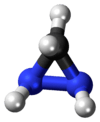Diaziridine
| |||
| Names | |||
|---|---|---|---|
| IUPAC name
Diaziridine | |||
| Identifiers | |||
| 3D model (Jmol) | Interactive image | ||
| ChemSpider | 4236879 | ||
| PubChem | 5059686 | ||
| |||
| |||
| Properties | |||
| CH4N2 | |||
| Molar mass | 44.06 g·mol−1 | ||
| Except where otherwise noted, data are given for materials in their standard state (at 25 °C [77 °F], 100 kPa). | |||
| | |||
| Infobox references | |||
Diaziridines are heterocyclic compounds containing two nitrogen atoms in a three-membered ring. They can be considered as strained hydrazines. Due to the ring strain, the nitrogen atoms are configuration stable leading to cis-trans isomers. They are usually synthesized by a method developed by E. Schmitz: A carbonyl compound is treated with ammonia or respectively a primary aliphatic amine and an aminating reagent like hydroxylamine-O-sulfonic acid (HOSA) under slightly basic conditions.[1] The final step is based on the intramolecular cyclization of an aminal.
Reactions
- Unsubstituted diaziridines are often directly oxidized (I2/NEt3) to the more stable diazirines.
- They can undergo ring expansion reaction with electrophilic reagents like ketenes or isocyanates.
- Some derivatives are neurotropically active.
References
- ↑ Synthesis of monocyclic diaziridines and their fused derivatives; N. N. Makhova, V. Y. Petukhova, V. V. Kuznetsov, Arkivoc, 2008(i), 128-152.
This article is issued from Wikipedia - version of the 7/7/2015. The text is available under the Creative Commons Attribution/Share Alike but additional terms may apply for the media files.

